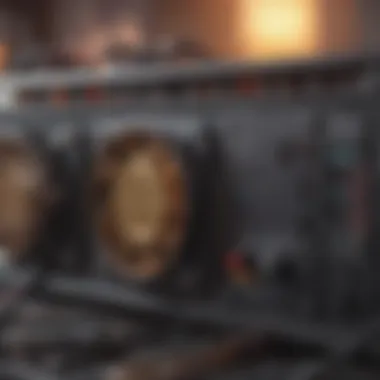Key Elements for Constructing a Mining Rig


Intro
In the world of cryptocurrency, the secret sauce to successful mining isn't just about cashing in on the latest coin frenzy. It's about building a rig that can keep up with the demands of the blockchain. Diving into the essence of this venture, it's crucial to grasp what a mining rig actually is. At its core, a mining rig is a specialized computer set up to solve complex mathematical problems, thereby validating transactions on the blockchain and earning rewards in the form of cryptocurrency.
An effective mining rig not only enhances your chances of earning revenue but also pushes you to stay ahead of the game in the ever-evolving landscape of digital currency. In this guide, we will dissect the essential components that contribute to assembling a successful mining rig, touching on hardware options, software frameworks, and logistical insights.
Key Concepts of Cryptocurrency
Understanding Blockchain Technology
At the heart of cryptocurrency mining lies the blockchain, a decentralized and distributed ledger technology. This is not just a buzzword kicking around the room; it's the backbone of most cryptocurrencies. Each transaction is recorded in what we call a “block,” which is subsequently added to a chain of previous transactions. This system guarantees transparency and integrity, but only if miners like you do the heavy lifting.
Comprehending the intricate details of blockchain technology can provide a leg up when selecting components for your mining rig. For instance, knowing how transactions are processed and validated can affect the way you're going to approach component selection. Some miners focus on mining coins with different protocols, which might require varied specifications from a hardware standpoint.
The Role of Cryptographic Security
Security is paramount in the realm of cryptocurrency. Cryptography underpins the entire operation, ensuring transactions are secure and immutable. Understanding cryptographic hashes and how they function adds another layer of comprehension, which is crucial for anyone venturing into mining. Essentially, miners compete to find the right hash—an output generated from a given input. This race contributes to securing the network and verifying transactions.
"A mining rig isn't just about coins; it's about trust, security, and ensuring every transaction that crosses the blockchain is verifiable."
Investment Strategies and Market Trends
Analyzing Market Dynamics
While building your mining rig, understanding market dynamics might seem like a secondary concern, but it can significantly impact your setup. The prices of different cryptocurrencies fluctuate wildly, influenced by various factors such as regulatory changes, tech advancements, or even social media trends. Keeping an ear to the ground in forums like reddit.com or viewing market updates on platforms like facebook.com can equip you with the foresight needed to optimize your mining strategy.
Savvy miners often tailor their hardware choice based on market trends. For example, if Ethereum experiences a spike in demand due to new partnerships, having a rig capable of mining Ethereum could provide better returns.
Risk Management in Crypto Investments
Much like any investment strategy, managing risk in mining is essential. You don't want to put all your eggs in one basket and then watch them hatch into a loss. Diversifying your mining portfolio isn't just advisable; it's wise. By mining different cryptocurrencies simultaneously, you can cushion the volatile nature of the market.
It's also vital to keep an eye on your operational costs. Knowing how much your electricity will run will give you a clearer picture of your potential profits. If you let these costs spiral out of control, you'll end up mining coins that aren't profitable, which is like throwing money down the drain.
In summary, crafting a mining rig isn't solely about hardware; it's a blend of technological insight and market savvy that can dictate your success. This guide serves as a compass for both newbies and veterans navigating the intricate waters of cryptocurrency mining.
Prelims to Mining Rigs
As the world leans more heavily into the digital realm, cryptocurrency mining has become a topic of public interest and lucrative potential. This article aims to break down the essential components needed to build an efficient mining rig. For many, diving into the world of crypto may seem overwhelming, with myriad technicalities and hardware choices. Therefore, understanding the fundamentals of mining rigs is not just beneficial, but crucial for making informed decisions.
The importance of mining rigs can't be overstated. At its core, mining is a process where users contribute computing power to validate transactions on a blockchain. This validation helps to maintain the integrity and security of not only cryptocurrencies but also decentralized technologies at large. As such, having the right equipment can lead to increased efficiency, more mining rewards, and a significant return on investment.
Understanding Cryptocurrency Mining
Cryptocurrency mining involves solving complex mathematical problems to verify transactions on a blockchain. At its surface, it seems like a straightforward process of execution; however, the intricacies behind the scenes are where the real challenge lies. Miners who successfully solve these problems are rewarded with newly minted coins, incentivizing the entire network.
But cryptocurrency mining is not merely about brute computing strength. It requires a fine balance of hardware choices, energy consumption, and maintenance. Inevitably, the task of selecting the right components for a mining rig becomes one pivotal point for achieving mining success.
Types of Mining Rigs
When it comes to mining, one size does not fit all. There are several types of mining rigs, each tailored to specific needs and preferences. Understanding these types can help in making a well-informed decision when setting up a mining operation.
- ASIC Miners:
ASIC miners, or Application-Specific Integrated Circuits, are machines designed specifically for mining a certain type of cryptocurrency. Their primary draws are efficiency and power. Unlike general-purpose GPUs, these miners can deliver higher hashing rates, which means they can solve equations faster and therefore earn rewards more readily. The heightened efficiency comes with trade-offs, though; ASICs can be expensive and limited in versatility, only able to mine specific cryptocurrencies. Still, for dedicated miners targeting coins like Bitcoin, the investment often pays off. - GPU Mining:
GPU mining employs Graphics Processing Units, best known for their application in gaming. They offer flexibility since they can mine various cryptocurrencies. This adaptability makes GPU rigs a popular choice among hobbyists who may want to explore different mining options. However, balancing performance and energy consumption is key. Even though GPUs reside at a lower entry price compared to ASICs, optimizing them for mining tasks can pose a challenge, requiring thorough tweaks and settings adjustments. - CPU Mining:
CPU mining utilizes the computer's central processing unit to mine cryptocurrencies. While this method is feasible, it's generally regarded as the least effective due to lower hashing power compared to GPUs or ASICs. One appealing aspect of CPU mining is that it allows general-purpose machines to partake in the process. Thus, for those wanting to dip their toes into mining without significant upfront investment, CPU mining can serve as an introductory option. However, as the difficulty of mining increases, the profitability of this approach tends to dwindle swiftly.
Core Components of a Mining Rig
Building a mining rig is akin to constructing the robust foundation of a skyscraper; without the right components, even the best designs can falter. The core components of a mining rig not only define its capabilities but also determine its efficiency in mining cryptocurrency. Each part plays a vital role in ensuring that the rig functions optimally, whether you're a novice just stepping into the crypto world or a seasoned miner looking to upgrade your setup. By selecting high-quality components, you can maximize your return on investment and enhance the overall mining experience.
Graphics Processing Unit (GPU)
The heart of any mining rig often lies in its GPU, as this component handles the heavy computations required for mining.
Choosing the Right GPU
When it comes to choosing the right GPU, several factors come into play. Look for GPUs that strike a balance between hash rate and power consumption. A higher hash rate indicates better performance in mining, whereas power efficiency helps reduce your electricity costs. Brands like NVIDIA and AMD dominate the graphics card market due to their strong performance and reliability.
One unique aspect of selecting your GPU is considering the memory. GPUs equipped with a higher amount of VRAM can handle more complex calculations. This is especially beneficial in mining altcoins that require significant memory bandwidth, making certain GPUs far more appealing in specific scenarios.
Cost vs. Performance
In the world of cryptocurrency mining, cost vs. performance is a perennial debate. Miners must analyze the upfront costs of a GPU relative to its performance. The key here is to gauge how quickly you can recoup your investment through mining rewards.
Unique features, such as enhanced cooling systems or factory overclocks, can boost performance but may also inflate costs. While high-performance GPUs can yield better results, ensuring they fit within your budget is critical. Often, mid-range GPUs offer a sweet spot, delivering respectable hash rates without breaking the bank.
Motherboard Selection
The selection of the motherboard is foundational, not only in terms of compatibility but also in performance.
Compatibility Considerations
When considering compatibility, it's paramount to ensure that your motherboard can support multiple GPUs if you plan to expand your rig. Features such as PCIe slot availability and size can greatly impact your setup's efficiency.
A motherboard with good compatibility typically provides the flexibility to add additional components down the line, accommodating growth without needing a complete overhaul. Choose motherboards explicitly designed for mining to simplify these compatibility issues.
Optimal Features
Beyond compatibility, examining optimal features is crucial. Look for motherboards that support high-speed RAM and have enough SATA ports for storage solutions. Also, some motherboards come with built-in features like overvoltage protection and enhanced power phases that help maintain stable operation during extensive mining sessions.


Power Supply Unit (PSU)
The PSU is another critical element because it ensures that your mining rig receives consistent power.
Wattage Requirements
Understanding wattage requirements helps to prevent overloading your PSU. An accurately rated PSU is vital, ensuring that it can handle the rig's maximum draw under load without fluctuations. As a rule of thumb, consider using a PSU with at least 20-30% extra wattage above your calculated needs to allow for efficiency drop over time.
This characteristic of building in a safety margin makes your mining setup more resilient and can also prolong the lifespan of your components. If you've chosen multiple GPUs, the wattage requirements will multiply, so careful calculations are essential.
Efficiency Ratings
Efficiency ratings, like the 80 Plus certification, indicate how effectively a PSU converts AC power from the wall into the DC power your GPU and other components require. Higher efficiency ratings mean less wasted energy and lower heat production, making for a cooler environment and lower energy bills—both significant advantages in the mining game.
A PSU with high efficiency typically has a higher initial purchase price but can lead to long-term savings.
Cooling Solutions
Keeping your equipment cool is another cornerstone of a successful mining rig, ensuring longevity and sustained performance.
Air Cooling vs. Liquid Cooling
Deciding between air cooling and liquid cooling is often subjective. Many miners prefer air cooling due to its simplicity and lower cost. Yet, air cooling can sometimes struggle with high-performance systems, leading to higher temperatures that may throttle performance. Conversely, liquid cooling, while more expensive and complex, offers superior cooling efficiency, making it a valid consideration for high-end setups.
Each system has its own advantages: air cooling is easier to set up and maintain, while liquid cooling systems provide quieter and, often, better thermal management.
Ventilation Strategies
Lastly, ventilation strategies must be at the forefront of your build process. Proper airflow around your rig can greatly reduce the risk of overheating. Ensuring that all components are placed to allow for maximum air circulation can mitigate heat. For those in particularly warm climates or where ambient temperature is a concern, investing in additional fans or airflow management tools can enhance performance and stability.
"Choosing the right components is the foundation for a successful mining operation. Each decision made at this stage can reverberate throughout the lifecycle of your rig."
By understanding the core components and focusing on practical considerations, you will be much better equipped to assemble an effective mining rig that maximizes potential gains. The synergy between each of these elements not only optimizes performance but also creates a more cost-effective operation in the long run.
Additional Hardware Requirements
When it comes to setting up a mining rig, hardware isn’t just a collection of pieces that do their respective jobs. The additional components you select can mean the difference between a successful mining venture and a huge headache. Each part plays a vital role in the overall functionality and efficiency of your setup. Here, we’ll dive into some of these key components, shedding light on their importance and considerations.
Frame and Setup
Building vs. Buying
Choosing between building your own mining rig frame or purchasing a pre-made one is a bit like deciding whether to handcraft your furniture or hit up IKEA. When building, you have full control over the materials and design; it's customizable to fit your specific needs. This can be a significant advantage, as you can tweak everything from the size to the airflow based on your understanding of your mining rig’s layout.
However, buying a ready-made frame often means less hassle and time spent. These frames are designed for quick assembly, and typically come with the necessary mounting points for graphics cards and cooling systems.
Overall, whether you choose to build or buy can influence factors like cost, time invested, and even aesthetics of your setup. Finding that sweet spot between professionalism and DIY charm is key when considering this aspect.
Space Considerations
Space isn't just about having enough room to fit your rig; it’s about optimizing that space for efficiency and heat management. An adequately planned space will help maintain airflow and prevent overheating, which could ultimately damage your equipment and efficiency.
When you scope out your mining area, think about accessibility too—having proper access to your rigs makes maintenance simpler. A good layout could enhance performance by allowing enough separation between rigs to minimize heat build-up.
From a practical standpoint, ensuring you have adequate power outlets and proper ventilation mustn’t be overlooked. Ignoring these factors could lead to regret down the line, particularly when you find your expensive equipment struggling because of a hot or cramped space.
Storage Solutions
Hard Drive vs. SSD
Choosing between a hard drive and an SSD is like opting for the tortoise or the hare in an age-old fable. Hard drives are generally more affordable and offer larger storage capacities, often making them the go-to choice for those just starting their mining journey. However, they have slower read and write speeds compared to SSDs.
On the flip side, SSDs might cost a pretty penny up front, but they significantly enhance the performance of your rig due to their faster speeds. For miners, quick boot-up times and the ability to load software rapidly can mean a more efficient workflow. Depending on how you plan your mining operations, these factors can have a big impact.
Capacity Needs
When assessing capacity needs, figure out how much data you plan to store. Not just your software, but records of your transactions, mining statistics, and any necessary configurations. A miner with robust ambitions should not underestimate data storage requirements.
It’s vital to strike a right balance between having enough space without going overboard. Analyzing current and forecasted storage needs might save some future headaches as you scale. The right storage solution contributes significantly to a smooth mining experience while keeping you from running out of space when you least expect it.
Cables and Connectors
Types of Cables Required
Cabling is like the unsung hero of your mining rig setup. You might not notice it at first glance, but without the correct cables, you can have all the powerful GPUs you dream of, and still get nowhere. Generally, you’ll need power cables, risers for the graphics cards, and potentially data cables if your configuration uses multiple drives.
Using the right type of cable ensures not only efficiency but also safety—subpar cables can lead to overheating or failures. Knowing what you need upfront can save some headaches later when all you want is to get those rigs up and running smoothly.
Cable Management Tips
Getting cables organized doesn’t just make the setup look neater; it can significantly help with cooling. Cluttered cables can restrict airflow, leading to increased temperatures and possible failures. Consider using cable ties or sleeves to keep everything in check and labeled.
Additionally, a well-managed cable setup can facilitate easier maintenance. You won’t have to fish through a jungle of wires to get to a particular component. For both new and seasoned miners, these tips truly enhance the longevity and effectiveness of a mining rig.
"In mining, every small choice can have large consequences."
In summary, carefully considering the additional hardware requirements will set you on the right path to fostering a sustainable and efficient mining operations. Assessing your needs, space, and management strategies can elevate an ordinary rig into something truly remarkable.


Software Essentials for Mining
When it comes to building a mining rig, the spotlight is often on hardware. But let’s not kid ourselves—software is the backbone that keeps the whole show running smoothly. Getting the software side right means ensuring a smooth operation, effective management, and maximization of earnings. It’s not just about the flashy components; it’s about how they play together. In the constantly evolving landscape of cryptocurrency, choosing the right software can spell the difference between a mining rig that flounders or one that flourishes.
Operating System Choices
Windows vs. Linux
In the world of mining rigs, choosing an operating system is akin to laying a solid foundation for a house. Windows often pops up as a common choice due to its widespread familiarity. Most users are accustomed to navigating its interface. However, Linux presents a unique allure with its robustness and superior performance in managing hardware resources, which can be a game-changer for mining tasks.
One of the standout features of Windows is its compatibility with a plethora of mining software. If ease of use is your bag, Windows provides a user-friendly experience. But it does come at a cost—license fees can pile up. Not to mention, Windows tends to consume more of your system's resources, which could hinder your mining efficiency.
On the flip side, Linux is open-source and free, making it an economically tempting option for many miners. Its ability to operate smoothly with a minimal footprint means more power is directed toward the mining process. However, this comes with its own set of challenges. Setting up Linux can be daunting for newcomers who might not be as tech-savvy. Yet, once you get past that learning curve, it can be a powerhouse in handling mining tasks.
Advantages of Windows:
- User familiarity
- Broad software support
Disadvantages of Windows:
- Higher resource consumption
- Licensing costs
Advantages of Linux:
- No costs associated
- Lower resource usage
Disadvantages of Linux:
- Steeper learning curve
- Fewer available mining applications
Setting Up the Environment
Setting up the environment for mining is no small feat; it’s where the hardware and software dance together to bring profitability and efficiency. A well-set-up environment allows miners to monitor performance closely, adjust configurations, and explore all potential optimization avenues.
For many, the attractiveness of cloud mining setups is undeniable. They provide a hands-off approach, allowing users to rent power without dealing with the nitty-gritty of hardware management. However, these come with a catch—fees and the risk of fluctuating contracts can nibble away at profits. Accessibility is a key characteristic that cloud solutions offer, removing the need for physical rigs.
Yet another approach involves local mining setups. You get total control here, but that means dealing with hardware, maintenance, and the potential for headaches. It requires careful planning and foresight.
Advantages of cloud mining:
- Low physical maintenance
- Immediate setup
Disadvantages of cloud mining:
- Can be less profitable
- Dependence on providers
Advantages of local mining setups:
- Full control over the rig
- Potentially higher returns
Disadvantages of local mining setups:
- Requires ongoing maintenance
- Higher initial investment
Mining Software Options
Popular Mining Clients
Mining clients are essential software programs that connect miners to the blockchain; they provide the interface for your rig’s efforts. Each client has its set of features that can cater to different needs and preferences. CGMiner, for instance, is a well-loved option in the mining community, particularly valued for its efficiency and high degree of customization. However, it requires a bit of technical know-how to get the most out of it.
Then there’s NiceHash, which draws in newer miners. It allows users to mine various algorithms easily, automatically switching between the most profitable ones. This flexibility is a key characteristic, maximizing profitability but with a slightly more hands-off approach.
Advantages of CGMiner:
- Highly customizable
- Manual configuration offers control
Disadvantages of CGMiner:
- Not beginner-friendly
Advantages of NiceHash:
- User-friendly
- Automated profitability
Disadvantages of NiceHash:
- Potentially lower earnings compared to solo mining
Configuration Settings
Once you’ve piqued your interest with the right mining client, the next step is to dive into configuration settings. Fine-tuning these settings allows the miner to optimize their hardware performance, increase profitability, and reduce wear over time. A key characteristic of configuration settings is that they let you personalize the mining experience, aligning it with your specific rig setup.
In most clients, settings will involve aspects like setting the appropriate pool and wallet addresses, as well as adjusting the mining intensity and GPU clocks. Striking the right balance in configuration is paramount—too cautious, and your rig underperforms; too aggressive, and you risk overheating or even hardware failure.
Advantages of effective configuration settings:
- Optimizes performance
- Tailors operation to hardware capabilities


Disadvantages of poor configuration settings:
- Potential losses in revenue
- Increased risks of hardware damage
In a nutshell, while hardware and electricity draw the limelight in the mining world, software lays the groundwork for a fruitful mining endeavor. With the right operating system, environment setup, software clients, and precise configurations, your mining rig can successfully navigate the murky waters of cryptocurrency mining.
What to Consider Before Starting Mining
Diving into cryptocurrency mining is akin to stepping into uncharted waters. There’s a lot to think about before you put your shovels down and get to work. You might be bursting with enthusiasm but it's crucial to look before you leap. The exploration of mining might be intricate, but there are pivotal questions and considerations that can make your experience not just endurable but truly profitable in the long-run. In this section, we will explore the costs involved, the operational implications, and the peculiarities of your local regulations that may affect your mining activities.
Electricity Costs
Calculating ROI
When considering the financial outlay of mining, the first step is understanding the potential return on investment, or ROI. This can be tricky, as it's not just about the price of equipment; you also need to factor in ongoing expenses like electricity. Depending on where you live, this can vary tremendously. Mining uses a hefty amount of power, and if your costs per megawatt are higher than the value of the currency you’re mining, your operation might end up costing you more than it earns.
The key characteristic of calculating ROI lies in tracking your energy consumption and comparing it against your rewards. If you’re pulling in steady blocks but the electricity bills are sky-high, then you're playing a losing game. It's vital to map out all your expenses versus your earnings, painting the financial landscape clearly. Save yourself from unpleasant surprises by running the numbers early on. This would mean looking up the efficiency of your hardware to choose options that balance cost and performance effectively.
Understanding Local Regulations
The road to mining isn’t just paved with profit-making opportunities; you’ve got to be aware of local regulations too. Different jurisdictions have various legal stances on cryptocurrency – whether they welcome it, tax it heavily, or even ban it outright. Understanding local regulations will help mitigate any unforeseen legal battles down the road.
What’s more, some locations offer incentives to encourage mining while others may impose limitations regarding energy usage. Knowing the legal landscape helps you avoid potential risks. Diligently research issues like licensing requirements, tax implications, and environmental restrictions that could impose hurdles on your mining endeavor. Being informed means you can operate with confidence, ensuring you’re playing by the rules.
Mining Pools vs. Solo Mining
When you decide to tackle cryptocurrency mining, you'll face the choice between joining a mining pool or striking out on your own with solo mining. Each approach serves a different purpose, suitable for varying resources and risk appetites.
Advantages of Pools
Joining a mining pool can lead to faster returns, which is a significant lure for many miners. The pooling of resources amplifies your mining power, enabling the group to solve blocks quicker than solo miners might accomplish. This means more frequent payouts, often at the cost of a small fee taken from your rewards. The benefits of this collaborative effort can be quite noticeable, especially for new miners who may struggle against the competition of seasoned solo miners.
Moreover, pools often provide a support network among members, sharing insights and strategies that can greatly alleviate the burden of the steep learning curve associated with mining. This camaraderie fosters a sense of community that can be motivational and beneficial for novice miners.
Is Solo Mining Viable?
Solo mining, on the other hand, is a path marked with both one-of-a-kind rewards and significant risks. If you’re using high-end hardware and are confident in your abilities to compete in the major leagues of mining, it could pay off big time. However, the reality is that the competition is fierce, with many mining powerhouses dominating the landscape. Thus, many solo miners find themselves receiving sporadic rewards, making sustained income elusive.
The unique feature of solo mining is the complete control over your operations. You set the standards, manage your hardware, and you alone reap the rewards sans the fees that pools might levy. But with independence comes the potential for inconsistent returns, leaving you at the mercy of luck and the evolving complexities of the market.
With all these considerations in mind, it becomes clear that diving into mining requires careful planning and foresight. Evaluating your electricity costs alongside understanding regulatory frameworks and weighing options between mining pools and solo efforts can make all the difference in your mining venture.
Future Trends in Mining Rig Technology
Understanding future trends in mining rig technology is crucial for anyone looking to invest in or upgrade their mining setup. As the cryptocurrency landscape evolves, so too do the tools that facilitate this digital gold rush. This section will delve into emerging technologies and environmental considerations that shape the future of mining rigs. By keeping a close eye on these developments, miners can make informed decisions that not only boost profitability but also reduce operational risks.
Emerging Technologies
FPGA Miners
Field-Programmable Gate Array (FPGA) miners represent a significant shift away from traditional mining technologies. One key characteristic of FPGA miners is their flexibility. Unlike ASIC miners, which are hard-set for specific algorithms, FPGAs can be reprogrammed for various cryptocurrencies. This adaptability makes them a popular choice among miners who want to keep pace with the fast-changing mining environment.
A unique feature of FPGA miners lies in their ability to optimize energy consumption. They use far less power compared to ASIC miners, thus reducing electricity costs significantly. However, the initial investment can be higher, and their programming may require a steeper learning curve. For miners seeking both efficiency and versatility, FPGA miners offer a balance of pros and cons that merits consideration.
Cloud Mining Solutions
Cloud mining solutions have gained traction for making cryptocurrency mining more accessible, especially for individuals who may not have the technical know-how to set up their own rigs. The key characteristic here is convenience; users can rent mining power from remote data centers, bypassing the hassles of hardware management and maintenance.
The unique feature of cloud mining is the model through which it operates. Users pay a fee to access a portion of the data center's hash rate, allowing them to mine without the need for physical equipment. While this approach lowers the barrier to entry, the advantages are often tempered by risks. Companies offering cloud mining can be opaque, and issues like difficulty adjustments or fluctuating fees may eat into potential profits. Still, for new miners, this method can serve as a manageable way to dip one’s toes into the mining waters.
Environmental Considerations
Sustainable Practices
Sustainability is becoming a hot topic in the cryptocurrency mining world. Miners are increasingly adopting sustainable practices as a way to mitigate their environmental impact. A key characteristic of these practices is the focus on renewable energy sources, like solar or wind, to power mining operations. Not only does this approach reduce carbon emissions, but it can also lead to substantial cost savings in the long run.
A unique feature of sustainable practices is their ability to improve a mining operation's public perception. As environmental scrutiny grows, miners who invest in eco-friendly solutions can differentiate themselves in a crowded market. Nevertheless, the transition to sustainable practices can require significant upfront investment and technological upgrades. For those committed to long-term viability, embracing sustainability is not just a trend, but a necessary evolution.
Carbon Footprint Implications
The carbon footprint implications of mining are gaining more attention, given the energy-intensive nature of the process. One of the major considerations here is the heavy reliance on fossil fuels in many regions, which exacerbates environmental issues. The key characteristic of focusing on carbon footprint is understanding how mining practices impact global warming.
Adopting strategies to minimize this footprint can lead to not only regulatory compliance but also improved public perception. Mining operations that actively work to offset their carbon emissions through reforestation, for instance, can attract a more conscientious investor base. However, the downside includes the complexities and costs associated with these initiatives, which may not be feasible for all miners.
"As the cryptocurrency industry matures, the sympathy for sustainable practices will increasingly guide investment decisions and operational tactics."
Culmination
When delving into cryptocurrency mining, the path taken can seem winding and intricate, but drawing everything together in the conclusion provides clarity. Mining rig construction is not merely about assembling hardware; it denotes a melding of technology, economics, and environmental consciousness. Weaving these threads together emphasizes why each component—be it the GPU or the PSU—holds significance in the rig's efficiency and overall performance.
A well-thought-out mining rig can be the difference between straightforward mining success and a frustrating journey riddled with challenges. For investors and traders, understanding these essential components can optimize returns. For developers, being aware of the underlying hardware enables fine-tuning of software to meet the rig's capabilities.
Why this conclusion matters:
- It crystallizes the intricate relationships among different mining rig components.
- It addresses vital economic factors like electricity costs, which can’t be overlooked when calculating potential profits.
- It sheds light on how trends impact future decisions, steering miners towards more sustainable practices that may resonate with environmentally conscious stakeholders.
In summary, having a coherent grasp of these fundamentals not only empowers miners but also enhances their overall approach to cryptocurrency mining—a venture that, if navigated wisely, can yield significant rewards. As the landscape continues to evolve, staying informed about these components isn't just helpful; it's imperative.
Summarizing the Key Takeaways
To sum up everything we’ve discussed:
- Choose the Right GPU: The differentiation in GPUs affects cost and performance; know which suits your needs.
- Consider the Power Supply: Assess wattage to avoid bottlenecks, while focusing on efficiency ratings to minimize electricity wastage.
- Storage Matters: Decide between hard drives and SSDs based on speed and capacity needs. The right choice can streamline the process.
- Select Software Wisely: The operating system and mining software can heighten performance depending on how they're configured.
- Think Long-Term: With trends like cloud mining and sustainable practices on the rise, this insight is pivotal in strategizing for the future of mining.
In all of this, remember the big picture: building and managing a mining rig isn’t just about immediate outcomes; it’s about positioning oneself optimally within a rapidly evolving landscape. Whether you're stepping into this world for the first time or fine-tuning an established setup, these takeaways will serve as a guiding light.







